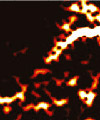June
Musical brain patterns could help predict epileptic seizures

New insights into the electrical patterns of the brain reveal how brain waves with rapidly increasing frequencies, like musical ‘glissandi’, could help predict when a patient is going to start an epileptic seizure.
The research led by Newcastle University’s Dr Mark Cunningham and Professor Miles Whittington and supported by the Dr Hadwen Trust for Humane Research, indicates a novel electrical bio-marker in humans.The brain produces electrical rhythms and using EEG - electrodes on the scalp - researchers were able to monitor the brain patterns in patients with epilepsy. Both in patients and in brain tissue samples the team were able to witness an abnormal brain wave noticeable due to its rapidly increasing frequency over time.
Comparing these to a musical ‘glissando’, an upwards glide from one pitch to another, the team found that this brain rhythm is unique to humans and they believe it could be related to epilepsy.
Dr Cunningham, senior lecturer in Neuronal Dynamics at Newcastle University said: “We were able to examine EEG collected from patients with drug resistant epilepsy who were continually monitored over a two week period. During that time we noticed patterns of electrical activity with rapidly increasing frequency, just like glissandi, emerging in the lead-up to an epileptic seizure.”
“We are in the early days of the work and we want to investigate this in a larger group of patients but it may offer a promising insight into when a seizure is going to start.”
Professor Whittington added: “Classical composers such as Gustav Mahler are famous for using notes of rapidly increasing pitch – called glissando - to convey intense expressions of anticipation. Similarly we identified glissando-like patterns of brain electrical activity generated in anticipation of seizures in patients with epilepsy.”
The team recorded electrical activity taken from patients in Newcastle and Glasgow with the help of collaborators Dr Roderick Duncan and Dr Aline Russell and worked in collaboration with the Epilepsy Surgery Group at Newcastle General Hospital part of the Newcastle Hospitals NHS Foundation Trust. Having received permission from patients to use brain tissue removed during an operation to cure their seizures, the team were able to observe and study in great detail glissando discharges in slices of this human epileptic tissue maintained in the lab.
Publishing in Epilepsia online, the team discovered that glissandi are highly indicative of pathology associated with human epilepsy and, unlike other forms of epileptic activity studied previously, are extremely difficult to reproduce in normal, non-epileptic brain tissue. The team worked with Professor Roger Traub at the IBM Watson Research Centre in New York to provide predictions using highly detailed computational models. By manipulating the chemical conditions surrounding human epileptic brain tissue according to these predictions, they discovered that glissandi did not require any of the conventional chemical connections between nerve cells thought to underlie most brain functions. Instead, glissandi were generated by a combination of large changes in the pH of the tissue, specific electrical properties of certain types of nerve cell and, most importantly, direct electrical connections between these nerve cells.
“This work also suggests that given the lengths one has to go to reproduce this experimentally in rodents that the glissandi may be a unique feature of the human epileptic brain,” explains Dr Cunningham.
Dr Kailah Eglington, Chief Executive of the Dr Hadwen Trust for Humane Research, said: “Of all human brain disorders, epilepsy research ranks as one that currently employs substantial numbers of laboratory animals worldwide.
“Dr Cunningham’s work at Newcastle University aims to address the shortcomings of existing animal-based research by removing animals from the equation and addressing the issue directly in humans.”
Publication: Glissandi: Transient fast electrocorticographic oscillations of steadily increasing frequency, explained by temporally increasing gap junction conductance. Mark O. Cunningham, Anita Roopun, Ian S. Schofield, Roger G. Whittaker, Roderick Duncan, Aline Russell, Alistair Jenkins, Claire Nicholson, Miles A. Whittington, Roger D. Traub. Epilepsia, 2012 (In Press)
published on: 16 June 2012
